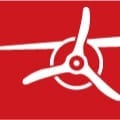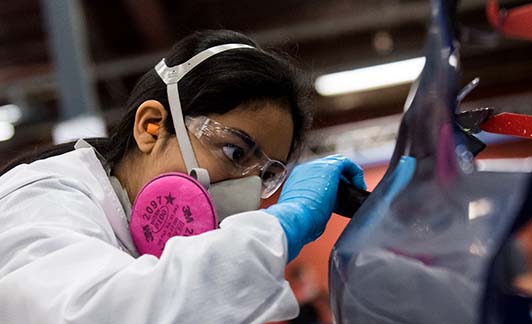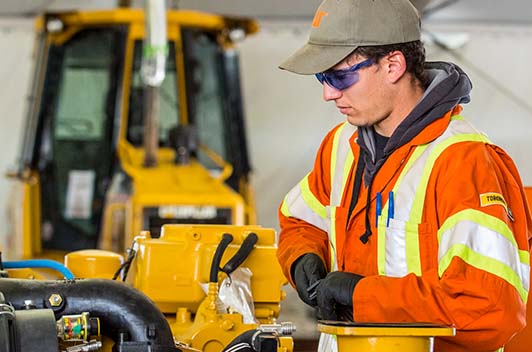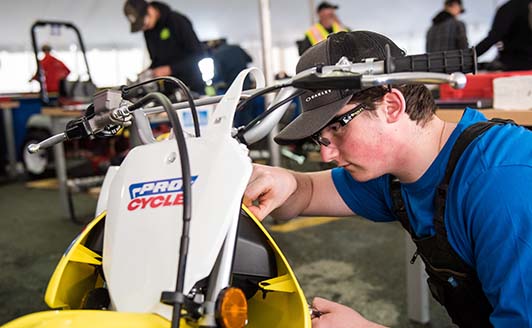Aerospace Technology
What is aerospace technology?
Aerospace technicians install, maintain, repair and overhaul aeronautical products including mechanical, electrical, hydraulic and computerized equipment. They must rigorously check and inspect equipment to make sure hazards are identified and corrected, and that they meet Transport Canada standards of safety and performance. Their work typically consists of assembling and disassembling equipment, inspecting it or performing routine maintenance, such as cleaning/lubricating or adjusting components and systems. An aircraft maintenance technician may specialize in specific aircraft systems as part of an AMO (Aircraft Maintenance Organization) shop such as engines, airframes, avionics or hydraulics.
With experience, aircraft maintenance technicians may progress to becoming a licensed AME. From this base, an AME can career path to many different areas within the Aviation Industry including but not limited to Aircraft Maintenance Supervisors, Inspectors etc.
Aircraft mechanics perform some or all of the following duties:
- Troubleshoot aircraft structural, mechanical or hydraulic systems to identify problems and adjust and repair systems according to specifications, technical drawings, manuals and established procedures
- Repair and overhaul aircraft structural, mechanical or hydraulic systems
- Install or modify aircraft engines and mechanical, hydraulic, flight control, fuel and pneumatic systems
- Dismantle airframes, aircraft engines or other aircraft systems for repair, overhaul and cleaning, and reassemble
- Perform and document routine maintenance
- Order and maintain inventory of parts and supplies
HOW TO JOIN THE FIELD
Completion of secondary school is required.
A college diploma in aircraft maintenance or completion of a four-year apprenticeship program is usually required.
Several years of on-the-job training are required for aircraft mechanics.
Aircraft mechanics and inspectors who sign maintenance releases and certify airworthiness require an Aircraft Maintenance Engineer’s (AME) licence issued by Transport Canada.
Trade certification for aircraft maintenance engineers is available, but voluntary, in Nunavut and the Northwest Territories.
Trade certification for aircraft structural technicians is available, but voluntary, in British Columbia.
Industry certification from the Canadian Council for Aviation and Aerospace for some occupations in this unit group is available, but voluntary.
Aircraft inspectors require several years of experience as an aircraft mechanic.
INDIGENOUS AND REMOTE CONSIDERATIONS
Many Indigenous and remote communities have mechanical knowledge, particularly when it comes to machines used to hunt. This enables people to fix machines in order to continue traditional hunting and gathering activities that sustain life. However, there may be less access to formal training on mechanical knowledge. Many fly-in communities do not have access to the types of equipment and workplace technology learn the ropes in this career. Students from these communities may need to relocate to get their education and training and may also need to travel to job sites once they get a career. However, mechanical knowledge is a highly desirable skill when it comes to life in remote communities where access to replacement parts and equipment is more limited than in other parts of the country.
Many Indigenous and remote communities do not have the same access to information and experience when it comes to science, mathematics and technology fields. This would likely mean that students from these communities may need extra support when they are pursuing this field both in post secondary school, as well as on-the-job.
Indigenous and remote communities are catching up to southern Canada when it comes to digital technology and computer skills and industries. Not all communities have access to reliable, affordable internet and service interruptions are all too common. Access to computers at home is not a given for everyone and Elders and even sometimes younger generations lack computer knowledge, although this situation is undergoing some significant changes at the moment. But even those people in Indigenous and remote communities with interest and high-level skills in computers may not have the same access to opportunities to learn about different programs and may face significant bandwidth issues, limiting their ability to learn and develop in this field. Indigenous and remote students may need qualifying courses or need to augment college learning to be successful in this field.
Although with significant improvements currently underway to internet connections in Indigenous and remote communities, careers in this field become more viable and are likely to become more so in years to come.
DISABILITY CONSIDERATIONS
As this field involves both complex thinking and analysis as well as physical operation, people with physical, intellectual and learning disabilities may need accommodations in order to be successful.
Find the right career path for you with our interactive map!
Trouvez le cheminement de carrière qui vous convient grâce à notre carte interactive!
Sample Job Titles
- Aircraft structures engineer
- Aircraft avionics engineer
- Aircraft systems inspector
- Aircraft mechanic
Companies and Sectors
- Aircraft manufacturers
- Airlines
- Aircraft operators

Aerospace Technology and the Skills for Success Program
The key Skills for Success for this career path are:
- Reading
- Numeracy
- Problem Solving



